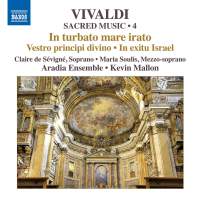Texte paru dans: / Appeared in: |
|
|
Outil de traduction ~ (Très approximatif) |
|
|
Reviewer: Michael
De Sapio Gone are the days when the D-Major Gloria was the extent of most listeners’ acquaintance with Vivaldi’s sacred music. The catalogs are now rife with recordings of the red-headed priest’s religious output, and Naxos is making its contribution with a Vivaldi: Sacred Music series featuring the Toronto-based Aradia Ensemble and assorted vocal soloists. This Volume 4 features three motets and three psalms. Scored for chorus and orchestra, the psalms are brief, energetic one-movement pieces in the best manner of “effective” 18th-century sacred music, getting through lengthy texts by means of choral declamations over dancing string accompaniments and chugging bass lines. Music like this must have sounded splendid in spacious Venetian churches and considerably enhanced worshipers’ experience of the liturgy. The motets are scored for solo voice and orchestra and consist of alternating da capo arias and recitatives, with concluding “Alleluias.” The booklet states that the motets would have been performed during Mass but does not go into the origins of the Latin texts; they are not liturgical and appear specially composed, much like opera librettos—and in a style of Latin prosody that owes something to the more mellifluous cadences of Italian. Indeed both the text and the music of the motets have a strong operatic element, channeled to religious ends. Take Invicti bellate (Unconquered, fight); this feisty piece, complete with imitations of war drums, wouldn’t sound out of place as a battle cry in an opera; the text speaks of Jesus as “dear eternal leader” (Dux aeterne Jesu care) and enjoins believers to “be brave in war” (fortes estote in bello). Or take the motet that opens the disc, In turbato mare irato (“In the turbulence of the angry sea”), applying a stock operatic trope to the upheavals of the soul in search of the “beacon of heaven,” here implicitly identified with Mary the Star of the Sea. For an extreme contrast, we have the joyful F-Major motet, Vestro principi divino, with its lilting pastoral aria (Prata, virete) describing the flowering of the meadow and its healing effect upon the “heart’s bitter pains.” In a similar vein is the E♭motet that closes the disc, O qui coeli terraeque serenitas (“O thou that art the calm of heaven and earth”), with its gently undulating opening aria invoking God’s providence; by contrast, the second aria (Rosa quae moritur) uses a descending bass line as the basis for a sort of musical memento mori (“The rose which dies ... the water which recedes, the world’s delights are all transient”).
Soprano Claire de Sévigné and
mezzo Maria Soulis are both excellent soloists, with fine timbres and good
musical instincts. De Sévigné wields her pure, gleaming voice with nice
precision, and Soulis is appreciably Italianate and particularly impressive
in the Prata, virete aria, winding her dusky voice around its curves with
suavely persuasive phrasing. This was my first exposure to the Aradia
Ensemble, and I was most impressed by its warm period string sound (no
abrasiveness here), neat precision of execution, and overall good taste. The
upper strings have some moments of patchy intonation while unmoored from the
basso continuo in Dux aeterne, but this is a minor flaw and conspicuous for
being so rare. The 12-strong Aradia Ensemble chorus makes their incisive and
agile presence felt. The recorded sound (St. Anne’s Anglican Church,
Toronto) has pleasing air and space. In sum, this is an enjoyable, balanced,
and well-performed program that should please anyone looking to explore
sacred Vivaldi beyond the ubiquitous Gloria. | |
|
|
|
|
Cliquez l'un ou l'autre
bouton pour découvrir bien d'autres critiques de CD |
|




